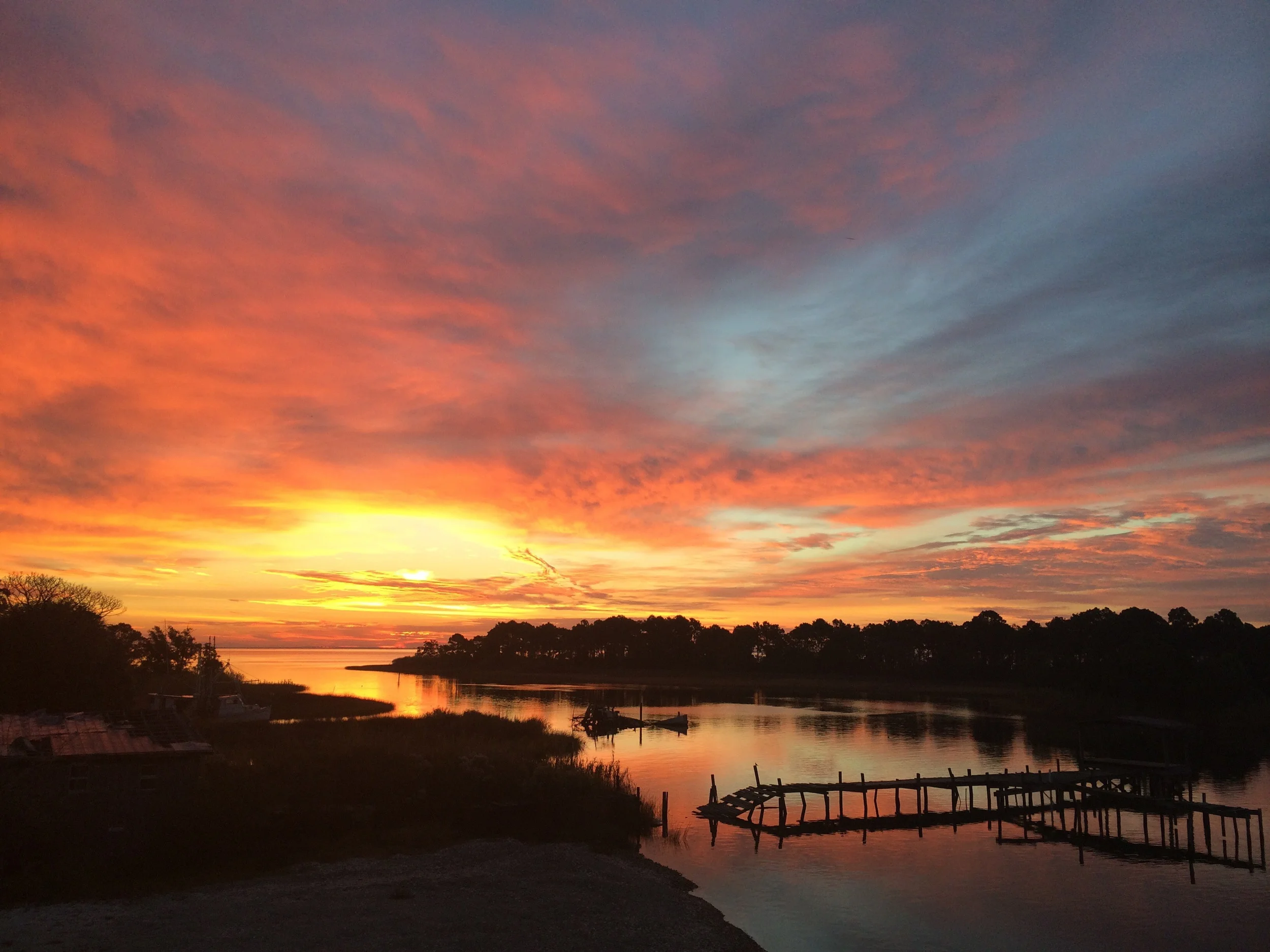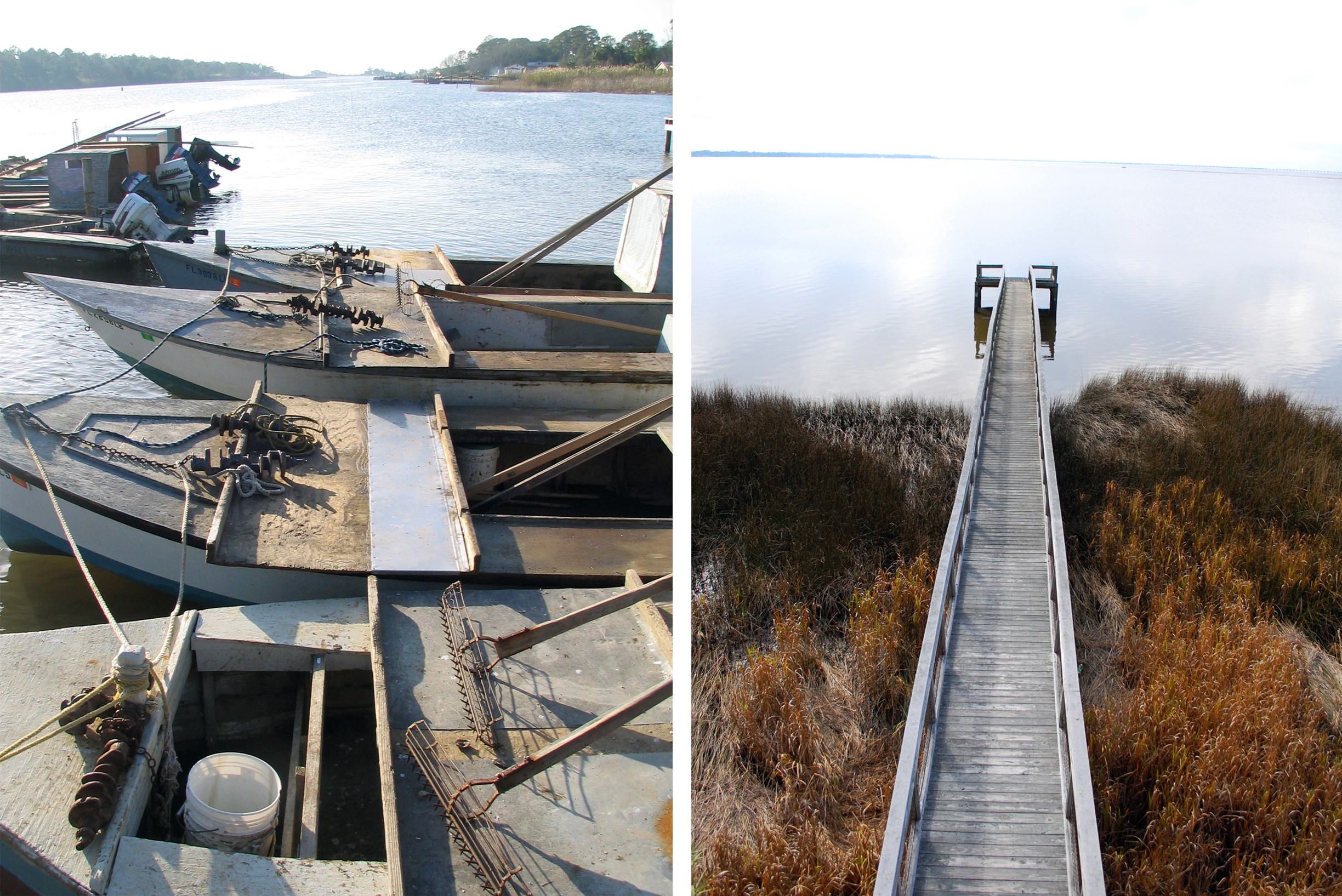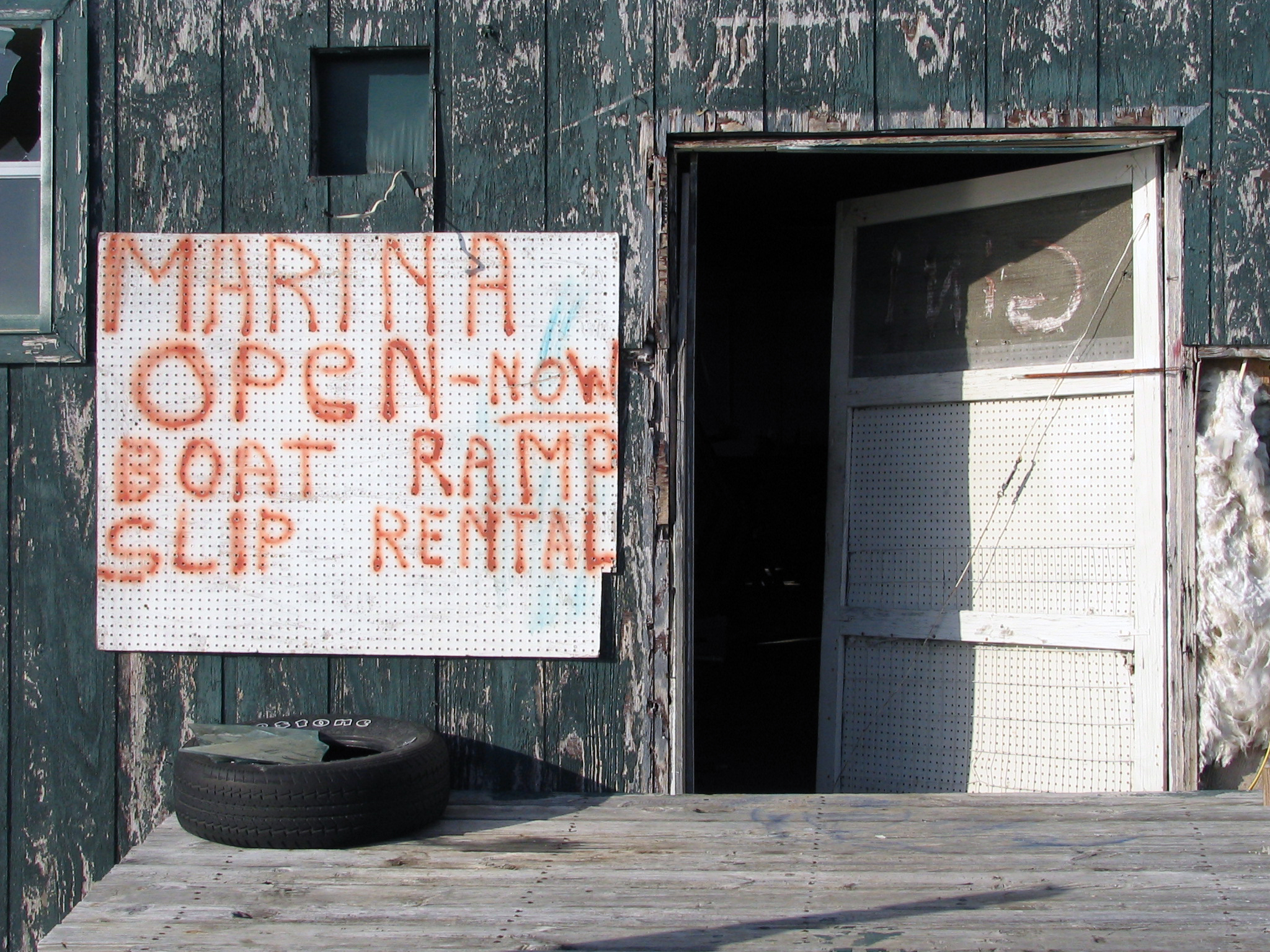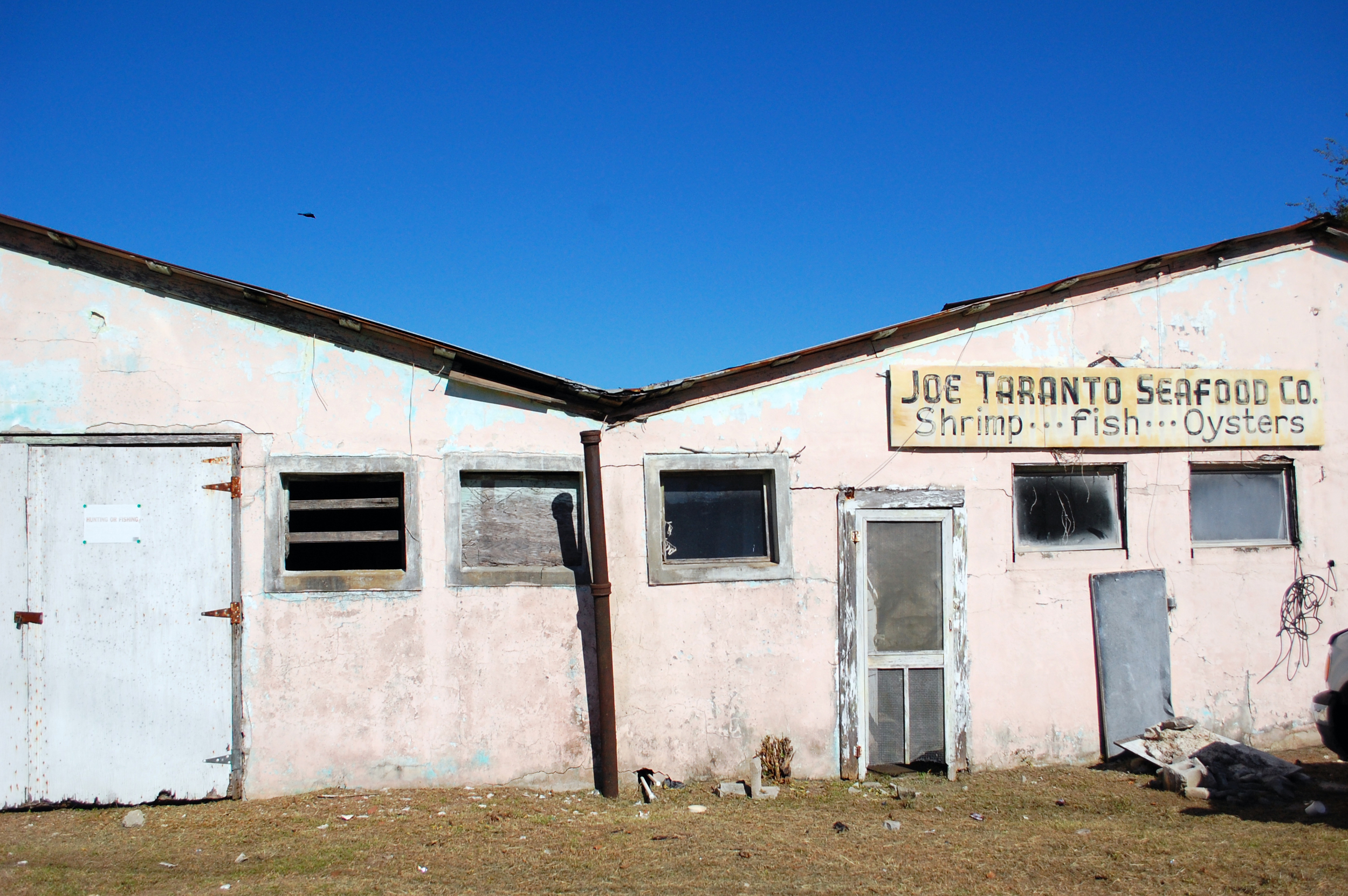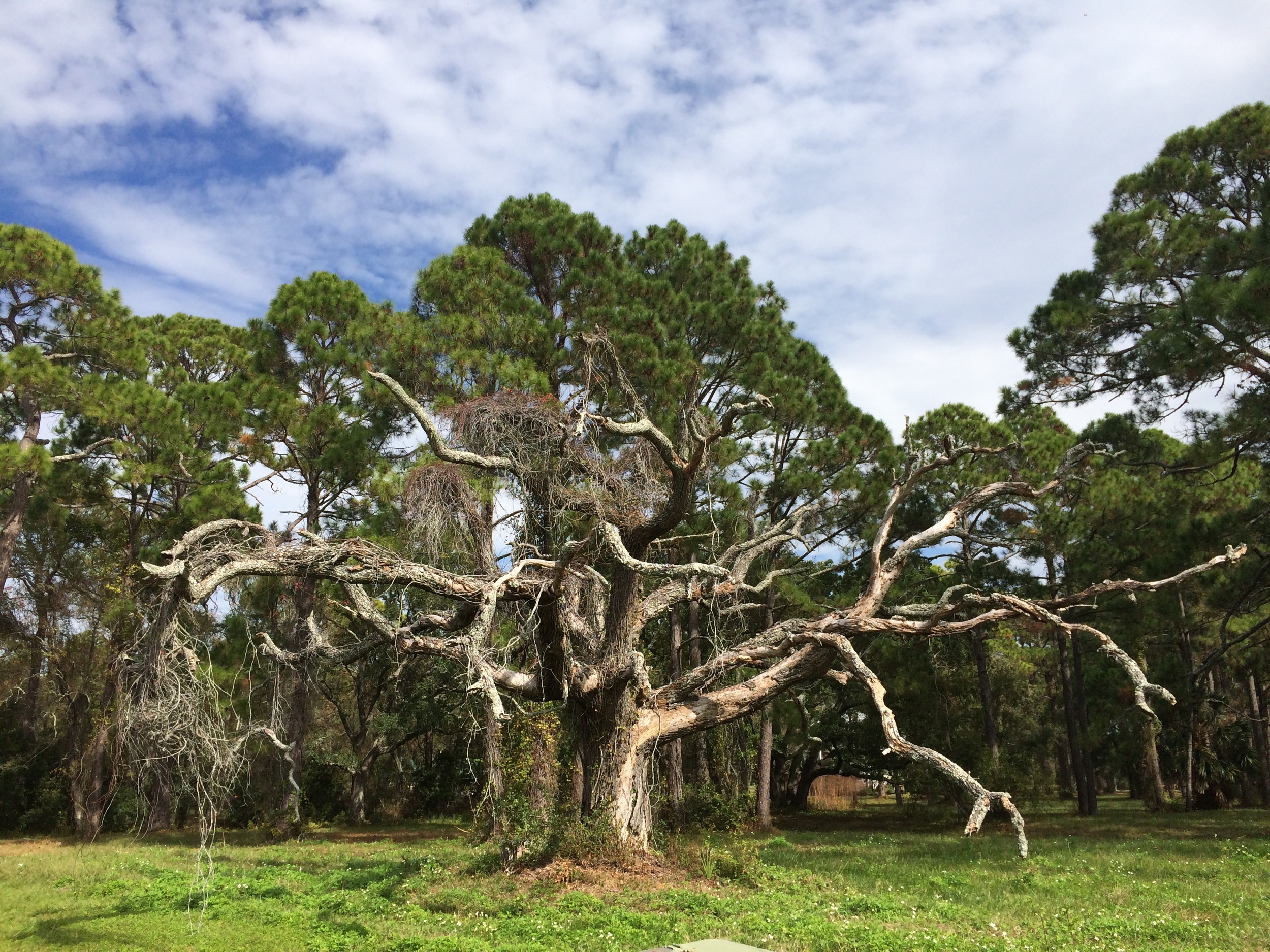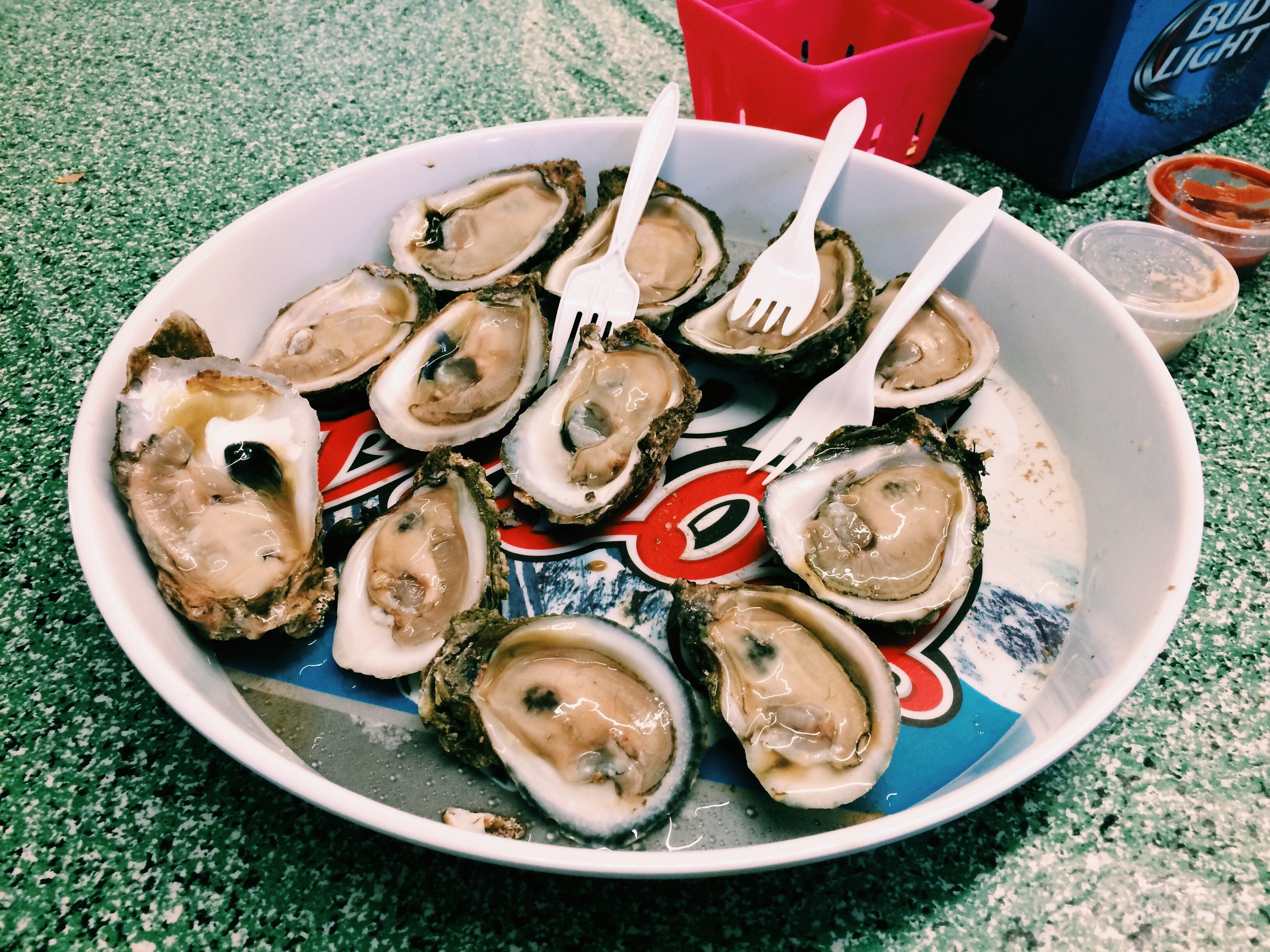The Oysterman
Unk Quick can read the floor of the Apalachicola Bay like a blind man reads braille. But now, with the bay yielding precious few of the bivalves that always meant prosperity to his family, Unk is, at age 73, beginning to learn reading of a different sort.
Portrait of A.L. "Unk" Quick taken at the Steamer's dock on the day he first met Amy Evans, 2006. Above, sunrise over Apalachicola Bay, 2014.
“I do not weep at the world — I am too busy sharpening my oyster knife.”
~ ZORA NEALE HURSTON ~
“God, bless it!”
We’ve been on the water for two hours. A. L. “Unk” Quick is leaning over the side of his aluminum boat, scraping the bottom of the Apalachicola Bay with 12-foot tongs, searching for oysters and calling out to the Lord above. He thinks his prayers have just been answered.
After more than half a century working on the water, Unk has an oysterman’s intuition. His hands feel the vibrations coming up through the worn wooden handles of his tongs, the steel rakes at the end rattling in just the right way, telling him he’s hit a bed of bivalves.
Unk snaps the handles together, lifts everything up out of the water, swings his body around, opens the tongs, and dumps a small pile of mud-covered clumps onto the cull board, where his wife Gloria separates individual oysters from the large clusters Unk pulls from the reef. They are beside themselves with anticipation. This time, though, Unk’s intuition turns out to be false hope: nothing but dead shells.
“There’s an oyster on this bay every now and then, “ Gloria says.
It has been eight years since I first visited Unk and Gloria Quick in Apalachicola, Fla. I met them when I was in the area to document the seafood industry in this part of the panhandle. Hurricane Dennis had just devastated the area, but it had also managed to clean out the bay. Oysters were plentiful. The industry was holding strong.
Those days are long gone.
Unk and Gloria Quick at Tate's Hell State Forest, and Unk feeling the bottom of the bay with his push pole, 2014. A cluster of dead shells in tong rakes, 2006. An entire day's paltry catch, 2014. Gloria shucking oysters at Lynn's Quality Oysters in Eastpoint, 2006.
In the fall of 2005, I made the first of three trips to Apalachicola to conduct interviews with people in the seafood industry on behalf of the Southern Foodways Alliance.
Of all of the fieldwork I did for the SFA — more than 300 interviews in 14 states over 13 years — this project has always had a hold on me. It was the part of the South I knew the least. It was also where I learned the most: how to sew seine nets and to tong for oysters, what it takes to harvest tupelo honey and cultivate soft- shell crabs. I forged some lasting connections there. And it’s the place I visited often in my memory to mine for inspiration for my paintings [also, this and this and this].
For the past eight years, I’ve wondered what would it be like for me to return.
Finally, last October, I bought a plane ticket. I was fueled by curiosity, but I was also embarking on a personal journey of sorts — an effort to connect the dots between where one part of me started and another part of me longed to be. And it was the fulfillment of a promise to the people I’d met in Apalach, as the locals call it: I had sworn to come back. I hadn’t even packed my suitcase, and I knew my return trip to Franklin County was somehow timed perfectly — that by finally committing to making this journey, the universe was offering reinforcement. During every step of planning, there were signs.
When searching the Internet for a place to stay, I happened upon a listing for an apartment situated smack on the edge of the Apalachicola Bay and above, according to the owner, a long-shuttered restaurant.
In 2005 that restaurant was Steamer’s, and the dock below was where I first met A.L. “Unk” Quick.
A 2014 view of the lot and the dock where oystermen would put their boats into the bay back in 2006, when Amy first visited.
Fishermen are a tight-lipped bunch.
Wary of government regulators and anyone who might have a hand in compromising their livelihoods, they’re generally not very quick to share, well, anything. At least that’s what I found on my first trip to Apalachicola. I had a couple of leads and a few contacts, but I was charged with documenting a wide variety of people and professions, so I had to pound the pavement looking for more. As with anything having to do with getting a story from a stranger, when you have the opportunity to visit with one person, you ask them to suggest someone else, which leads you to another story and another and so on. I’d been eager to interview an oysterman, but I hadn’t yet gained a foothold in the community.
Then I met Albert “Corky” Richards, an oyster tong maker in Apalachicola. I visited his workshop up on Bluff Road and got a crash course in tong making, mullet fishing and custom cabinetry. Since Corky crafted tongs for practically all of the oysterman in Franklin County, I asked him how I might connect with someone for an interview.
“Go down to the dock at Steamer’s. That’s where all of the oystermen are coming in this time of year,” he said. “Tell them Corky sent you.”
The rake at the end of Unk's 12-foot tongs, resting on the boat's cull board, 2014.
There were dozens of oystermen coming in off the bay that day at Steamer’s. Some men were hooking their skiffs to trailers, others were bagging their catch and weighing it on the dock. There was lots of activity and, at first, I just took it all in. I also took photographs. I got the name and number of a married couple who lived up the road in Carrabelle. I chatted up a man working the scale. I took more pictures. Then, as the activity slowed and trucks pulled away, I noticed one more oysterman far off in the distance, making his way to the dock. He was a straggler. A loner. I struck up a conversation as he slowed his skiff a good bit from the shore.
A. L. “Unk” Quick spent no less than an hour with me that afternoon, answering my questions, showing me how to use oyster tongs, telling me about the different parts of the bay. He readily agreed to meet me the next day for a formal interview. Soon afterwards, I met his wife Gloria, who shucked Unk’s catch at Lynn’s Quality Oysters across the bay in Eastpoint. The three of us made a date to meet at the Apalachicola Burger King for milkshakes. Shakes at the BK have been our standing date for all of my subsequent visits.
Unk and Gloria have been my tether to Franklin County since I last visited in 2006. We’ve kept in touch, trading phone calls and Christmas cards. I talk about them all the time to anyone who will listen. I spoke of Unk when The Bitter Southerner did a profile of the SFA last year. I have a necklace that I had made from the pearls Unk gave me, pearls that Gloria found while shucking his catch. In a 2013 interview, I declared the sharing of milkshakes with Unk and Gloria at the Apalachicola Burger King to be my favorite meal of all time. After all, a memorable meal is more about the company than the food.
The first thing I did when I arrived in Apalach for my recent visit was to meet Unk and Gloria at the Burger King. It was a Saturday night. The parking lot was all but empty. I pulled up next to what I immediately recognized as Unk’s truck, stopping to find my headlights beaming directly onto the booth where Unk and Gloria sat waiting for me, just like they were eight years ago. Only this time, there wasn’t much talk about oystering. Instead, we talked about kindergarten.
Amy's reunion with Unk and Gloria at the Apalachicola Burger King, 2014.
You might have heard tell of the political, environmental and ecological failures affecting Franklin County, Fla., and putting in question the fate of the Apalachicola Bay. Over the past handful of years, the bay has taken many punches: the BP oil spill and the company’s use of oil dispersants, overharvesting, the legal battle between Florida and Georgia over water rights that has now made its way to the U.S. Supreme Court, and natural predators invading the over-salinized waters as a result. Today, the industry is suffering mightily. The oysters are all but gone. People are out of work. Oystermen are selling their boats. And lifelong oystermen like Unk are forced into trying to eke out a new kind of living.
On land.
That night at the Burger King, when I was reunited with Unk and Gloria, I passed an envelope across the table. In it were pictures of my 5-year-old daughter, whom they have never met. I watched Unk hold one up and stare at it for a minute before asking, “Is she in kindergarten?” To which he quickly added, “I’m in kindergarten.”
Unk quit school when he was a teenager. He floated through, mostly, never learning to read or write. And then he floated out, choosing instead to earn a living on the water. Unk hung up his oyster tongs a couple of years ago, when the fate of the bay appeared to be all sewn up. For the past good while, instead of spending his days sitting on a boat, making use of his 50-plus years of experience working on the water, he spends three days a week sitting in a classroom, reviewing flashcards.
In 1993, Congress enacted the Unemployment Compensation Amendments, which require states to establish and utilize a system to work with unemployed residents whose regular work has, for one reason or another, disappeared. This applies to seasonal workers in general and oystermen in particular. The program helps them to secure alternative employment. The State of Florida has something called the Workforce Investment Act Program that carries out relevant initiatives. More specifically, it offers financial assistance to out-of-work oystermen, so they can get additional education and training, all in an effort to make them more desirable as potential hires. For a lot of former oystermen, this means training to become a corrections officer, an in-demand job with a good salary and state benefits. What it means for Unk is this: getting paid to work toward his GED diploma at the age of 73.
Unk may not have much schooling. He may not be able to read a menu at the local oyster bar. But after the day I spent on a boat with Unk and Gloria, looking for oysters that weren’t there, I can tell you what he does know: every single inch of the Apalachicola Bay. He recognizes every bump and crevice and soft spot below, feeling its topography like a blind man reads braille. He can tell the bay’s salinity by the smell of the air and the color of the water. Unk can look at landmarks along the shore to tell exactly where he is at any given moment. And he can look at a clump of mud and shells and know whether it’s going to be a good day or a bad one. These days, pretty much every day is a bad one.
But that day, out on the water with Unk and Gloria, even though we only had two dozen oysters after five hours of hunting, was a very good day. Back on land, we took our half-filled five-gallon bucket of bivalves back to their house in Eastpoint and enjoyed a bona fide feast.
The first time I set foot in Apalachicola, I had my first meal at the Wheelhouse Raw Bar.
It was a cold November night, and I sat alone inside, devouring a dozen oysters and some mullet dip. Outside on the dock, facing the river, were two men — two sailors — warming themselves in front of a Chiminea: Mike from Massachusetts and Richard from Michigan. They lived on their sailboats and made ends meet by doing odd jobs in town. Melanie Cooper Covell, owner of the Wheelhouse, let Mike dock his boat in front of the restaurant. They told me stories about the place and gave me a long list of characters to seek out while I was in town.
I figured Mike and Richard would’ve moved on by the time I made my way back to Apalachicola eight years later. But nope, they were still there.
After the oyster feast at Unk and Gloria’s in Eastpoint, I drove back over the bridge to Apalachicola and my temporary home above the old Steamer’s. It had been a long day, and I was tired, but something told me to take a turn toward downtown and see what I could find happening on a Tuesday night in this sleepy little fishing town. Bowery Station looked like it was hosting a lively crowd of locals, so I decided to stop in for a well-deserved drink after a long day on the bay. Within five minutes of being there, I noticed a familiar face at the bar: Mike’s.
“I still have all of those blues CDs you gave me,” he said almost immediately. I ask about Richard, and Mike pointed to a portrait of him on the wall. He was still around and a celebrated character in town. I grilled Mike about all of the other people whom I hoped to find while I was in the area — people I had interviewed all those years ago. He told me that Melanie sold the Wheelhouse. The old Deep Water Marina and Boat Yard was now condos, and its former caretaker, Wes Birdsong, was living over in Eastpoint.
The next day I got an invitation to join Mike at Wes’s house for drinks. We gathered in Wes’s garage-slash-woodshop where we drank wine, ate steamed shrimp and talked about Apalach. I asked Wes if he kept anything from the Deep Water Marina & Boat Yard before it was torn down. He pointed to a tall stack of wood in the corner: salvaged floorboards.
Of the many people I’d visited with so long ago, I knew that two were already gone. Corky Richards, the tong maker, passed away in 2008. Later that same year, we also lost Genaro “Jiggs” Zingarelli, a 90-year-old WWII veteran who spent his days printing oyster tags, the information labels that appear on each and every bag and box of bivales, and plied his trade in a time capsule of a shop in downtown Apalach. I knew what had happened to Jiggs, but I had no idea what became of his Franklin County Press. That is, until I went back. Sadly, Jiggs’ old print shop is now just another gaudy boutique, selling high-dollar trinkets to tourists.
I found out that Fred Millender, a salty one-of-a-kind character who operated Fred’s Best Seafood in Eastpoint, passed away just a few months before my return. He had been in the seafood business for more than five decades and passed away last year at the age of 88. I learned about Fred’s passing from one of his nephews. I had stopped in Fisherman’s Choice Bait & Tackle in Eastpoint to say hello to owners Charles Pennycuff and his son Rex, whom I last saw in 2006. Charles was catching me up on how the seafood community was getting along, talking about how shrimpers were now using their boats to harvest cannonball jellyfish for the Asian market. All of a sudden, Charles called out to a large man who had just walked into the store.
“Ask him about the jellyfish,” Charles said. The man introduced himself as Tony Millender, a shrimper, and I immediately asked if he was kin to Fred. Of course he was. We reminisced about his late uncle, and then he handed me his smartphone to show me pictures of his latest jellyfish haul. Afterwards, Charles took me to lunch down the street at Lynn’s Quality Oysters — now Lynn’s Oyster Bar & Retail Market — where we shared a few dozen of Franklin County’s finest, the rare few that come through her doors. I got to catch up with Lynn, and had a front row seat to the gossip of the day.
This would be the theme of my trip. It happened again and again: finding people right where I left them, as if our conversation had just been interrupted for a brief moment, and I was circling back after taking a phone call or ordering another round of oysters. I found James Hicks and his wife Oddys behind the bar at Papa Joe’s. I met Tommy Ward and his son T.J. at their 13 Mile retail market downtown. And on one particularly fortuitous morning, I happened to drive by the long-shuttered Taranto’s Seafood to find Anthony Taranto’s son Joey working inside, loading up all of the metal to sell for scrap. Anthony, now 83, came down minutes later, shared stories about his family’s old seafood house, and then drove me around for the better part of an hour, pointing out landmarks and reminiscing about the days gone by in this tight-knit little fishing village on the Apalachicola Bay.
Porter’s Bar. Cabbage Top. Cat Point. Picaleen.
To the people who make their living on the water, these names are familiar. They are the vernacular references to the oyster bars or low-lying reefs that populate the Apalachicola Bay. On the day I went oystering with Unk and Gloria, I think we anchored over at least three. When Unk wasn’t finding oysters at any of them, Gloria finally called out, “Let’s go to Paradise.” She was talking about another oyster bar, but she could have been talking about something else entirely.
Many natives of this place believe Franklin County to be the Garden of Eden. Not just a facsimile, mind you, but the Garden of Eden. This was made abundantly clear on my first trip to the area, and Unk and Gloria quickly reminded me of it on this last visit — my first night, in fact, when we met for milkshakes at the Burger King.
“Have I shown you the pearl I found in a catfish head?” Unk asked me.
We had been talking about a particular fern that Unk had told me about on another trip, and I was trying to get more details about it. I thought I had remembered the cross-section of the stem had the initials “JC” in it to represent Jesus Christ. But Gloria corrected me.
“No, it has ‘IC’, which stands for ‘I see,’ as in ‘I see you,’ when God found Adam and Eve naked in the Garden of Eden,” she said. I immediately declared that we had to get our hands on one of those fronds. Unk pledged to find one for me on one of our outings over the course of my visit.
And then he made mention of the catfish pearl.
Unk took out his wallet, dug deep into the fold, and then placed a small white bead on the table. It looked like a pearl all right, but it was kind of flat and had a spine-like edge on one side. Unk found it while cleaning a hardheaded catfish, also known as a saltwater catfish. Back up behind the fish’s eyes, he told me, are these calcified orbs that people have come to symbolize as the lots that were cast for Jesus’s robe. Gloria added that, if you leave the fish carcass out to be eaten by ants, when it’s cleaned, it will look like Christ on the cross. (Google knows this to be the Legend of the Crucifix Fish.)
Unk holds a catfish pearl, Apalachicola Burger King, 2014.
I heard more legends and tales on our drive out to Tate’s Hell State Forest. Unk and Gloria wanted me to see the dwarf cypress trees, so they drove me about twenty miles inland to find them. They knew right where they were going, of course. It just took us a while to get there. While we were in the car, I heard stories. Lots of stories. Like the one about Mr. Tate and his own personal hell [longer version here] and how Bloomer Creek Bridge got its name (yes, there were bloomers involved).
Walking through the wilderness with Unk and Gloria, I got an impromptu biology class. They commented on just about every plant we saw, every bird that flew overhead and every muffled sound that came from deep within the old-growth pine forest. On one stop, Unk pointed out an artesian well that he vowed to return to and clean up, since the opening had become covered up with leaves and debris. On our drive back to Apalach, Unk yelled out that he saw one of those Garden of Eden ferns down in a ditch. Gloria circled back around and parked on the side of the road. We got out of the car, and Unk jumped down into the ditch to cut a length of fern. He walked it back up for me to see, but the stem was too dry to be able to make out the initials.
About 10 feet away, Gloria spotted something else. “Is that deertongue?” she asked Unk. He bent down and cut off a handful of leaves with his knife and put them up to his nose.
Deertongue smells like vanilla. Native Americans harvested it for its myriad medicinal uses. Throughout most of the twentieth century, it was harvested as a flavor additive for tobacco products. Unk mentioned that he considered harvesting and selling deertongue himself at one point, but then tobacco companies stopped using it altogether, opting for chemical flavor additives instead.
This is but one more in a long list of revelations about this place, and something that Unk and Gloria have known all along: It offers up everything anyone needs, from sustenance and an honest living to natural cures and signs of faith. But, as with most things, this magical Eden in the Florida panhandle is not immune to the changes brought by regenerating natural cycles or the ills of human folly.
Back in the car, Unk refuses, as usual, to put on his seatbelt. “I wish they’d outlaw those things. I hate ’em!”
This is a man who never sits still for long.
I try to imagine him sitting in a school desk. In kindergarten.
Unk cuts a piece of fern on the way out of Tate's Hell State Forest and shows the detail of the cross-section of the fern's stem.
Oysters thrive in brackish water.
Fresh water from the Apalachicola River makes its way down into the bay where it meets salt water from the Gulf of Mexico. It’s a delicate balance. If you spend any time in Franklin County, you’ll hear stories about the wind-driven bay. Wind coming from the east brings more freshwater into the bay from the river. Wind from the west brings more saltwater from the Gulf. Oystermen read the wind to know when and where to get their catch.
“They took my living when they cleaned this bay,” Unk declared more than once during my visit.
While he hasn’t oystered in almost two years, Unk has held onto his rig — just in case. He can’t quite commit to the idea of never being able make a living on the bay again — that brackish water is in his veins.
On the days when Unk isn’t in school, he works as a janitor at the Apalachicola Senior Center, which opened its doors in 2012, right about the time Unk gave up on oystering. Our first night together at the Burger King, I asked Unk if he missed it. He didn’t hear my question. I didn’t ask again.
I will always treasure my time on the water with Unk and Gloria, sitting in a boat together, eating Nabs and hunting for oysters. I loved listening to their stories, taking in the scenery and over-documenting the entire event.
They, however, felt defeated. Again.
“This should make you want to stay in school and keep at it,” Gloria said to Unk as he pointed the boat back toward shore. “At least you’re making money by going to school, because you’re not going to make it in this bay.”
But maybe things will change. I sure hope they will. If I’ve learned anything about this place, it’s that Mother Nature always holds the best hand.
Back home in Texas, reading back through anthropologist Gloria Jahoda’s 1967 book, “The Other Florida,” I realize that, while everything about this place seems to teeter constantly on the edge of extinction, what we must really do is keep listening — and going back:
“Middle Florida is a mixture of tragedy and loveliness, every moment spent looking at it is filled with unutterable poignancy. The wind of change will blow. Perhaps it will be a whirlwind. Not yet, say voices that are tired or hopeful or fearful or disappointed, all of them together. All, you understand, have managed to make the music you have heard while you have wandered through their forests and fields and rivercourses and swamps. And always, too, they have said simply, ‘Welcome.’”
Gloria opens an Apalachicola Bay oyster, Eastpoint, 2014.
POSTSCRIPT: It’s Sunday night, and Gloria and I have driven an hour and a half west of Apalachicola to Panama City to play bingo. We enter a cavernous hall, and Gloria chooses a couple of seats for us at a banquet table near the back. She settles in, unpacks her ink daubers, and lays out a grid of paper bingo cards. A game is in full swing, but I have no idea how to acclimate to what’s going on, so I to head to the snack bar for a Diet Coke.
As I make my way across the smoke-filled room, I notice a sign above the cash window: “Welcome to Paradise.”

